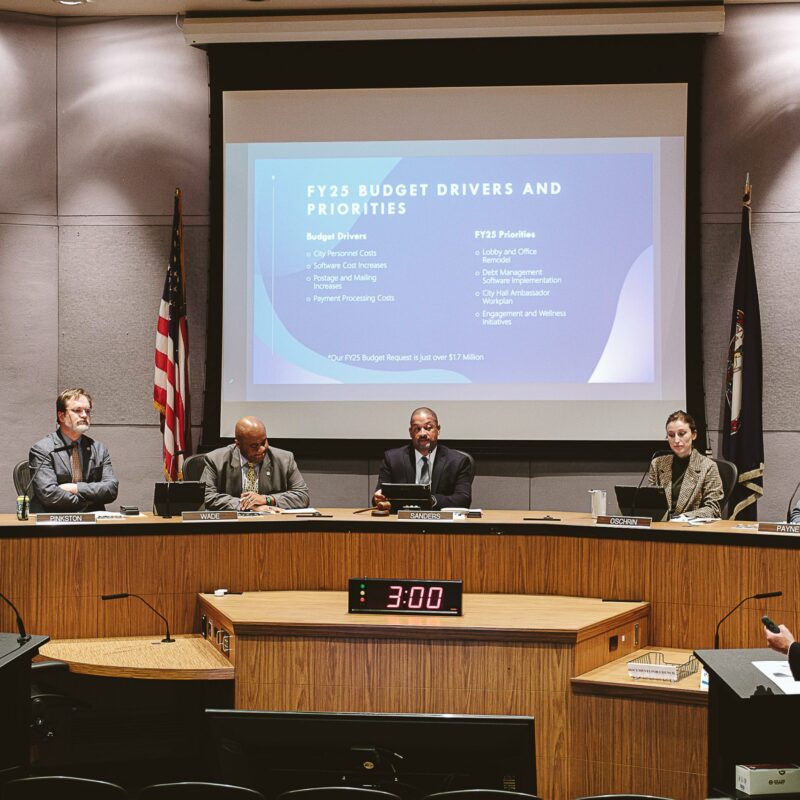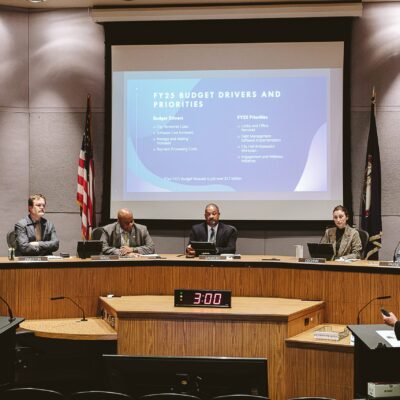Last month two Charlottesville men, George Huguely V and Barry Bowles, were convicted of second degree murder for killing their sexual partners. Huguely’s trial was national news and Bowles’ was an afterthought, but they were shockingly similar cases. Both men had convictions for violence and alcohol abuse, both had choked their victims in incidents prior to killing them, and both of them beat first degree murder raps that would have put them in prison for life.
|
An associate professor at UVA’s School of Nursing, Kathryn Laughon is also a forensic nurse examiner who processes rape victims. Laughon helped to organize the 2012 Nursing Network on Violence Against Women International’s research conference, which focused on the public health risk posed by intimate partner violence. (UVA) |
You may never have heard the phrase intimate partner violence, but you know what it is. Domestic abuse, date rape, and murder all fall under the umbrella. IPV is relatively new label for an old problem, and it draws its power from the notion that violence, particularly against women, is an acute public health threat in addition to being an ancient social issue.
Last week the UVA School of Nursing hosted a three-day conference—the annual research presentation of the Nursing Network on Violence Against Women International—that placed Bowles and Huguely’s convictions into larger context.
Kathryn Laughon—one of the conference organizers, an associate professor at UVA’s School of Nursing, and a forensic nurse examiner who processes rape victims—said the two local cases point to the need for concerted efforts to educate people about the red flags associated with intimate partner violence.
“We need to stop thinking about violence as a private issue between two people. Lots of people knew that Yeardley Love had been strangled. A number of people knew that Rachel Bowles had been strangled,” Laughon said. “In neither case did those women get the information that this is a serious red flag for lethal violence.”
Laughon’s scholarly publications include a research paper that shows if a person experiences non-lethal choking at the hands of an intimate partner they are six times more likely to become a victim of intimate partner homicide.
Murder is the most extreme outcome in cases of IPV, but a 2010 Center for Disease Control study accumulated data across categories of violence against women—sexual assault, stalking, and IPV—shows it is the tip of a statistical iceberg that links violence against women to life long negative health impacts, like increased incidence of sexually transmitted diseases, depression and PTSD, and poor reproductive health.
“Violence often begins at an early age and commonly leads to negative health consequences across the lifespan,” the study says.
In Virginia, according to the CDC, 31.3 percent of women (971,000 women) have been raped, stalked, and/or physically sexually assaulted in their lifetimes. More than half (51.1 percent) of female victims of rape reported being raped by an intimate partner and 40.8 percent by an acquaintance. Most female victims of rape (79.6 percent) experienced their first rape before the age of 25; and 42.2 experienced their first rape before the age of 18 years.
Increasingly, nurses are at the forefront of the clinical public health research on sexual violence and the NNAVWI brought together leaders from as far away as Hong Kong and New Zealand to talk about research trends in the field, successful public health programs, and to compare the social and cultural contexts that often set the stage for partner violence.
One of the conferences keynote speakers, Dr. Elizabeth Miller, who has worked with NIH and the CDC to create the clinical framework for IPV, brought the issue back to its most basic level during her final address.
“Whatever gender transformation work we can do is going to be part of the solution,” she said.
In other words, this is about changing the way men and women relate to one another.
Teach the children
Locally, the Sexual Assault Research Agency (SARA) is in its second year of a school-based primary prevention initiative designed to educate children from an early age about healthy sexual relationships. As a result of the public health research being conducted by people like Miller and Laughon, education programs like SARA’s have implemented a new approach, which basically involves changing and altering the behaviors of perpetrators by focusing on the people who surround them.
Laurie Jean Seaman is a SARA adolescent educator currently working with middle school students at Nelson County Middle School and Buford Middle School in Charlottesville “to build in them positive skills and attitudes that are going to keep them and the people around them from becoming perpetrators.”
The effort is a response to the story the data tells. The CDC’s report says the numbers “provide further evidence that when victimization occurs, particularly when it occurs in childhood, it is often repeated in adulthood,” and the danger mostly exists in the behavior of a small minority of men.
“I would say there’s a growing evidence base for this and a realization that we have to help keep victims safe but if we’re really going to make a change we have to focus on the perpetrators,” Laughon said. “The research shows that a very small number of men perpetrate but they perpetrate against a lot of women.”
SARA’s primary prevention program marks a change from past education efforts in that it focuses intensively on a few schools with the intention of building a lasting curriculum that follows students through their school experience. The programs start with teaching young children about their bodies. Fourth and fifth grade students learn about human interaction skills, boundaries, communication, and empathy. By middle school the skills are directly related to sexuality.
Seaman said the program adds a different level of understanding to the fare traditionally taught in health classes.
“Most schools, they’re going to cover STI’s and pregnancy prevention pretty decently. What scares me the most is that kids are not getting the relational social aspect of it,” Seaman said.
Starting early is important because kids start talking about and experimenting with sex early. Thirty percent of school-aged children are sexually active by high school and by their senior years over half have had sex.
“We can’t just pretend ‘My kid won’t be exposed to this at all,’” Seaman said, adding that kids who have talked to their parents about sex are more likely to delay having their first sexual experience.
The research shows that there’s more to education than teaching about birth control and abstinence. One in five teen girls have sent nude or semi-nude pictures of themselves, and while overall 8 percent of pregnancies are impacted by abuse, that number is two to three times as high amongst teenagers. In a study conducted in public health clinics in Boston, 40 percent of 14- to 20-year-old girls reported experiencing physical or sexual violence at the hands of a partner.
The numbers can be alarming to parents of teenagers, but the message Seaman has for them is surprisingly simple.
“Don’t wait to talk to your child about sexuality in general and don’t make it a one time conversation,” Seaman said. “We’ve seen form studies that with one time conversations often times kids don’t remember it at all. If kids don’t get it from their parents they’re getting it online or from their peers.”
Not talking about sex has its own consequences. Seaman is changing the culture at Buford Middle School by teaching the members of seventh and eighth grade sports teams about sexual assault, sexual harassment, and dating violence.
“The whole goal in both of these programs is to build bystander interventions skills,” Seaman said. “They’re not learning about these things so they can protect themselves; they’re not even necessarily learning about it so they won’t go out and do it; they’re learning about it so when they spot these things that they step in and change the course of what’s happening.”
The data has shown that between 20 and 30 percent of kids use sexual harassment and sexually coercive behavior to cause harm, but most use it because they think it’s normal.
“What happens when the kids’ sexuality is so taboo is it becomes an awkward, jokey thing and no one can really take it seriously as either a fun, positive, healthy part of life or as a very hurtful thing that if it happens without consent will harm a person for the rest of their life,” Seaman said.
To close the loop with the research, the primary prevention programs are designed to create a culture where perpetrators of sexual violence are easily identified as outliers, rather than being able to hide behind a screen of commonplace inappropriate behaviors.
There’s nothing casual about calling someone a “fag” or a “slut”, but in surveys children have widely indicated they see that behavior as normal.
“If that’s sort of seen as normal and accepted among our kids, which in some ways is what we are seeing in our studies, then people who are on the path to becoming a perpetrator can hide in that culture. It’s sort of a big concept, but it’s really about social norms,” Seaman said.
SARA recently added 40 minutes of video training for adolescents to its website, in addition to pages of teaching resources for parents and teachers.
“In the schools from talking to teachers, administrators and counselors, there are a lot of people who feel the urgency, but it’s hard to know what to do about it, because what we need is social change and that’s slow moving,” said Seaman.
Learning from Bowles and Huguely
In 2003, UVA fourth-year Monica Long was killed by her husband, 42-year-old Arnold Valenzuela in a murder-suicide at the couple’s home in the Trophy Chase apartment complex. Yeardley Love’s killing wasn’t the school’s first intimate partner homicide, but it has spurred the school to institute some measures to confront the issue of sexual violence more broadly, starting the Let’s Get Grounded campaign, a student-run program that has trained 1,500 students, faculty and staff to combat the “bystander effect,” which, according to its mission “results in the acceptance of disrespectful behavior among peers, including but not limited to acts of bias, derogatory comments, drug and alcohol abuse, and violence.
UVA has also implemented an anonymous reporting program, called Silent Watch, which uses Officer Angela Tabler as a first point of contact in both reporting and outreach training efforts that reached 18,000 people during 2011.
Laughon, who is often the first point of contact for a woman who has experienced a sexual assault and decided to report it, says the school’s efforts are good steps, but to be successful in stopping the next tragedy the school needs to implement a more robust education program that conveys specific information about how and where sexual violence happens, how perpetrators behave, and why it’s important to report incidents.
“When we have young women come in it’s often in the context that they’ve both been drinking and her attitude is, ‘I don’t want to ruin his life over one misjudgment,’” Laughon said. “But what we know is that was likely not one misjudgment, it was likely one in a series of calculated, deliberate assaults.”
UVA recorded 39 incidents of forcible sexual assaults between 2008 and 2010, but Laughon believes the actual number of incidents is likely much higher. She says that in addition to training students to be safe on campus at night, students also need to be trained that sexual violence almost always happens in familiar social settings at the hands of people who are familiar to the victims.
“Most of the violence that happens to women, and this is really the gender piece of it, happens in someone’s house, either where they live or where someone else they know lives, at the hands of someone they know,” Laughon said. “When it happens in that sort of social setting, our minds are not prepared to see it as a dangerous and violent behavior the way we would in a dark alley at night.”
The murder of Rachel Bowles didn’t get the media attention that Love’s did, and one could fairly say that has to do with the fact that her story was too ordinary by media standards to garner the same amount of attention. Bowles wasn’t young and she wasn’t a UVA lacrosse player. She was a black woman of working class in an abusive domestic situation that she couldn’t escape, and she ended up dying as a result.
“We get a lot of information about the really unusual cases. Stranger kidnappings. The really sensational cases,” Laughon said. “The fact that half of women are murdered by their intimate partners never seems to come out, despite the fact that in the first two months of this year we had two of those murder trials. It’s happening right in front of us and it’s not being recognized for what it is.”
The Jefferson Area Childrens Health Improvement Program serves low-income children and their families in Charlottesville, Albemarle, Fluvanna, and Louisa counties. Using materials developed by Miller, home visiting teams are now trained to identify health threats linked to sexual violence.
“Some of the training that they talked about at UVA helps our staff to develop the skills of conversation but also the skills of observation that might lead them to determining how domestic violence may be impacting health outcomes or birth outcomes,” said executive director Judy Smith.
The mothers in CHIP’s programs are on average just 22 years old and have 10th grade educations. Many of them are economically and socially isolated. In some cases, they are in abusive relationships where sexual violence, coerced pregnancy, and other forms of intimate partner violence threaten their physical and mental health and the health of their children.
“For the families that we serve, the lack of education, the lack of a support system, and the lack of money makes it even more difficult to talk about it and to get away from it,” Smith said.
The most current research shows that women who don’t use birth control or require repeated treatments for STIs are often aware of the risks they face but are afraid to use the public health resources available to them because they are in abusive relationships.
Smith described one young mother’s case, which took months to discover.
“It was when we actually got her to a doctor’s appointment and we were with her by herself that she began to talk to us about the fact that he wanted her to be pregnant and she did not want to and he did it to keep her at home,” Smith said. “Because of that she really wasn’t able to take care of the children she had. He was forcing pregnancy on her by not allowing her to use birth control.”
The home visiting program puts CHIP’s staff on the front line of the fight against IPV, but the problem hides out in the open.
“So often what we do is plant an idea or a thought or just let them know that we are concerned,” Smith said. “She could say everything’s fine that day but she may remember that we asked the question and it will open the door for her. You’re very rarely going to walk into a home and say, ‘Are you being abused?’ and have them say, ‘Yes.’”
In other words, to make change, Smith’s trainers have to dig beneath the surface, a good lesson for the rest of us.
/Kathryn_Laughon.jpg)





